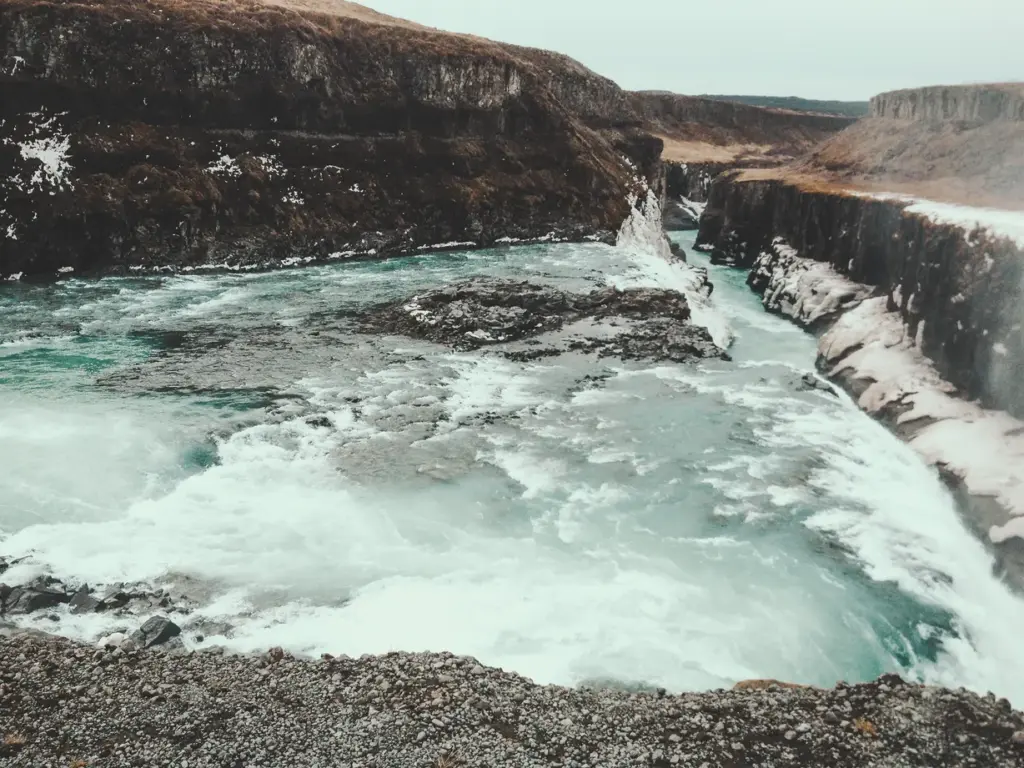Introduction to Gullfoss
Known as the ‘Golden Waterfall,’ Gullfoss is one of Iceland’s most iconic natural attractions. Located in the Hvítá river canyon in Southwest Iceland, Gullfoss offers a breathtaking display of nature’s power and beauty. This awe-inspiring waterfall cascades dramatically over two stages, falling a total of 32 meters into a rugged canyon. With its stunning vistas and compelling history, Gullfoss is a must-visit destination for travelers seeking to immerse themselves in Iceland’s untamed landscapes.
Not only is Gullfoss a visual wonder, but it also holds significant historical and ecological importance. The area around the waterfall is part of the Golden Circle, a popular tourist route that includes other nearby attractions like the Geysir geothermal area and Þingvellir National Park. A visit to Gullfoss offers more than just photo opportunities; it provides a deeper understanding of Iceland’s natural heritage and environmental preservation efforts.
The Geology Behind Gullfoss
The formation of Gullfoss is a fascinating tale of geological forces at work over millennia. The waterfall is part of the Hvítá river, which originates from the Langjökull glacier, Iceland’s second-largest ice cap. As the glacier melts, it feeds the Hvítá river, which travels southward and eventually plummets down the basalt cliff in two dramatic drops, creating Gullfoss.
The upper fall drops about 11 meters, while the lower fall plunges 21 meters into a narrow, deep crevice that disappears from view, adding a sense of mystery and wonder to the scene. The tumultuous waters and roaring sound contribute to the grandeur and allure of Gullfoss, making it a prime spot for both nature lovers and geology enthusiasts.
History and Cultural Significance
Gullfoss is not only a natural marvel but also a site imbued with rich cultural history. One of the most compelling stories associated with Gullfoss is that of Sigríður Tómasdóttir, a local farmer’s daughter who played a pivotal role in preserving the waterfall. In the early 20th century, there were plans to harness Gullfoss for hydroelectric power. Sigríður, deeply passionate about protecting the waterfall, vehemently opposed the project, even threatening to throw herself into the falls in protest.
Her relentless efforts and advocacy eventually led to the conservation of Gullfoss, and today, she is remembered as a pioneering environmentalist. A memorial plaque near the waterfall honors her legacy, reminding visitors of the importance of preserving natural wonders for future generations.
How to Get There
Getting to Gullfoss is a straightforward journey from Iceland’s capital, Reykjavik. The waterfall is approximately 120 kilometers (about 75 miles) away, making it a perfect day trip destination. Travelers can choose between renting a car and driving independently or joining one of the many guided tours that operate out of Reykjavik. The drive takes about 1.5 to 2 hours and offers scenic views of Iceland’s diverse landscapes, including rolling hills, volcanic fields, and tranquil farmlands.
Once at Gullfoss, visitors will find ample parking and well-marked paths leading to various viewpoints. The western shore offers the most panoramic views, allowing you to witness the full spectacle of the falls. There are also facilities nearby, including a visitor center with restrooms, a café, and a gift shop, ensuring a comfortable visit even in the cold Icelandic weather.
Best Time to Visit
Seasonality plays a crucial role in the Gullfoss experience, and each season offers a unique perspective of the waterfall. Summer months (June to August) are the most popular among tourists due to the relatively mild weather and extended daylight hours. During this time, the surrounding landscapes are lush and green, and the falls flow vigorously, fed by the glacial meltwaters.
Winter (December to February) transforms Gullfoss into a magical icy wonderland. The falls and surrounding areas are often blanketed in snow, with icicles adding an extra layer of beauty. While winter visits require more preparation due to the cold and potentially icy paths, the serene, almost otherworldly ambiance makes it a rewarding experience.
Activities and Nearby Attractions
While Gullfoss is undoubtedly the centerpiece of any visit to the area, it is far from the only attraction. The Golden Circle route, which includes the waterfall, is packed with other must-see sites. The nearby Geysir geothermal area features active geysers, including the famous Strokkur, which erupts every few minutes, sending water jets high into the air.
Þingvellir National Park, another Golden Circle highlight, is a UNESCO World Heritage Site rich in history and geology. It is the location of Iceland’s ancient parliament, Alþingi, and sits at the rift between the North American and Eurasian tectonic plates. Visitors can explore the park’s stunning landscapes, which include rift valleys, volcanic fissures, and crystal-clear lakes.
Sustainable Tourism at Gullfoss
Sustainability is a core value in Icelandic tourism, and initiatives are in place to ensure that Gullfoss remains protected and pristine. Visitors are encouraged to stay on designated paths to minimize environmental impact and to respect the local flora and fauna. The visitor center provides educational resources on the importance of preserving Iceland’s natural beauty, promoting responsible tourism practices.
Efforts to maintain the area also extend to waste management and infrastructure improvements, ensuring that increased tourism does not lead to environmental degradation. Travelers can contribute to these sustainability efforts by being mindful of their actions, supporting local businesses, and traveling with eco-friendly tour operators.
Photography Tips
Gullfoss is a photographer’s paradise, offering countless opportunities to capture breathtaking images. For the best shots, consider visiting during the golden hours (early morning or late afternoon), when the light is softer and casts a warm glow over the falls. A tripod can help stabilize your camera for long-exposure shots, which beautifully capture the movement of the water and create a sense of motion.
Vary your perspectives by exploring different viewpoints around the waterfall. The lower viewing platform offers a close-up view of the falls, while the higher vantage points provide a more comprehensive panorama. Pack weather-resistant gear, as the spray from the falls can be significant, especially on windy days.
Why You Should Visit Gullfoss
A visit to Gullfoss is more than just ticking an item off your travel bucket list; it’s an opportunity to connect with nature’s raw power and beauty. The combination of the stunning waterfall, rich history, and surrounding attractions makes Gullfoss a highlight of any Icelandic adventure. Whether you’re a nature enthusiast, a history buff, or simply looking for a unique travel experience, Gullfoss offers something for everyone.
The emotional impact of standing before Gullfoss, feeling the spray on your face and hearing the roar of the water, is truly unforgettable. It’s places like Gullfoss that remind us of the incredible beauty and power of our planet, and why it’s so important to protect these natural wonders for generations to come.



